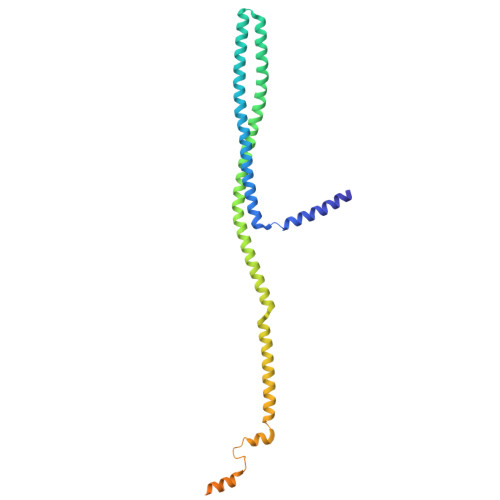Structural basis for Vipp1 membrane binding: from loose coats and carpets to ring and rod assemblies.
Junglas, B., Kartte, D., Kutzner, M., Hellmann, N., Ritter, I., Schneider, D., Sachse, C.(2024) Nat Struct Mol Biol
- PubMed: 39379528
- DOI: https://doi.org/10.1038/s41594-024-01399-z
- Primary Citation of Related Structures:
8QFV, 8QHV, 8QHW, 8QHX, 8QHY, 8QHZ, 8QI0, 8QI1, 8QI2, 8QI3, 8QI4, 8QI5, 8QI6, 9EOM, 9EON, 9EOO, 9EOP - PubMed Abstract:
Vesicle-inducing protein in plastids 1 (Vipp1) is critical for thylakoid membrane biogenesis and maintenance. Although Vipp1 has recently been identified as a member of the endosomal sorting complexes required for transport III superfamily, it is still unknown how Vipp1 remodels membranes. Here, we present cryo-electron microscopy structures of Synechocystis Vipp1 interacting with membranes: seven structures of helical and stacked-ring assemblies at 5-7-Å resolution engulfing membranes and three carpet structures covering lipid vesicles at ~20-Å resolution using subtomogram averaging. By analyzing ten structures of N-terminally truncated Vipp1, we show that helix α0 is essential for membrane tubulation and forms the membrane-anchoring domain of Vipp1. Lastly, using a conformation-restrained Vipp1 mutant, we reduced the structural plasticity of Vipp1 and determined two structures of Vipp1 at 3.0-Å resolution, resolving the molecular details of membrane-anchoring and intersubunit contacts of helix α0. Our data reveal membrane curvature-dependent structural transitions from carpets to rings and rods, some of which are capable of inducing and/or stabilizing high local membrane curvature triggering membrane fusion.
Organizational Affiliation:
Ernst-Ruska Centre for Microscopy and Spectroscopy with Electrons, ER-C-3/Structural Biology, Forschungszentrum Jülich, Jülich, Germany.














